Making Online Teaching Effective is now Easy

It’s been an entire academic session after the paradigm shift due to COVID, and the light at the end of the tunnel is nowhere in sight. The pandemic and the following lockdown forced the school system from one of ‘no screens if you want to study’ to ‘only screens if you want to study.
As I write this, the new session has commenced and all our hopes of moving back to in-campus education stand quashed, at least for now. Teachers have once again braced themselves to teach online through various platforms available. But it has become loud and clear that unless certain improvements in online teaching methodologies are made, the teaching-learning process will remain insipid and ineffective.
I notice, that students are increasingly losing interest in what the teacher speaks online. I also find that the learning outcomes are not as desired. The gaps in learning and the long-term deficits are so alarming, that in my opinion, the online teaching framework needs to be re-evaluated; even though the teachers’ community may want to believe that they are doing all that they can.
The first thing that can be improved in online teaching to make it interesting and thereby effective is that the teachers can ensure that the students are given clear instructions on the rules in their classes viz. readiness of the students with textbooks, notebooks, stationery before her slot starts, students joining the ‘meeting’ on time, and so on. They can also set rules about how to raise questions in the class by raising the virtual hand and waiting for the teacher to grant permission to speak, to give a thumbs up if they are clear with the concept being taught.
There is a lot of distance between the teacher and the taught within the virtual classroom because of the interaction through screens. This distance is amplified manifolds if the videos of students, as well as the teacher, are not on. The teacher is not able to gauge the comprehension of her students on the one hand, and the students are denied the inputs that they may get from being able to see the teacher as she speaks.
Thus, the most important step that the teacher can take to make her classes effective is to ensure that each of her students keeps their videos on. In my humble opinion, this single step will increase the efficacy of a teacher’s transaction of the content exponentially. Of course, teachers express their apprehensions about the breach of privacy or students making memes; but these are issues that are much minor and handleable when compared with the loss of a better learning experience that the teacher can give with the video on. Besides, the school authorities can be roped in to set the defaulter student straight.
Nothing weakens the learning process than a monotonous chalk-and-talk. This is true of the physical classroom. By the same token, if the teacher does not make use of the options of screen sharing, whiteboard, annotation, and so on, her teaching will dispel the students from taking interest in her classes.
Energy, interaction with students by giving personal attention, and giving students the freedom to give their inputs also contribute to making her classes interesting. Students must be given the freedom to unmute themselves, the chat facility must remain enabled for students to send their queries as you teach, and also with bigger children you can allow them to share their screens, to add to the class if they have some additional information (of course after your prior permission). The teacher must also make an effort to bring additional information about the topic in the syllabus.
Constant counselling of the students by the teacher to focus in class just as was done in physical classes is also necessary. The virtual classroom also requires that the teachers make efforts to provide individual attention to the students.
The teacher must use a laptop or desktop to conduct her classes instead of a smartphone. The bigger screen affords her the option of gallery view which enables her to give attention to many students at one time. The smartphone may at best be used for conducting the online class only in case of an emergency of no internet, laptop breakdown, and so on.
Finally, it’s been a year! Every teacher must now ensure that she is tech-savvy at least in handling the platform that she is using for carrying out online classes. A teacher fumbling with the features of Zoom/ Google Classroom/ Microsoft Teams, which are the most extensively used online teaching platforms, spells laziness on the part of the teacher to learn and is completely unacceptable. A whole year is sufficient for even the most technologically challenged person to gain proficiency over any or all of these platforms.
Device not charged is a crime on the part of the teacher that’s completely unforgivable. The Internet can sometimes get tricky; hence the teacher must also keep her smartphone ready to handle any eventuality. A disrupted class is about just as worthy as a no class.
Wishing that all teachers have equipped themselves with skills, insights, and know-how by now. I hope that the teachers’ fraternity would make additional efforts to provide their learners an enriched learning opportunity through online classes.
Categories
Tags
Recent Posts
- Release Notes for Vawsum Web Version & Admin Panel Version – 2.11
- Release Notes for Vawsum Web Version & Admin Panel Version – 2.10
- Release Notes for Android Version 4.83
- Release Notes for Vawsum Web Version & Admin Panel Version – 2.9
- Release Notes for Vawsum Web Version & Admin Panel Version – 2.8







Recent Comments